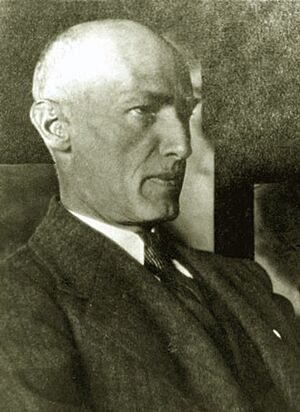Eligiusz Niewiadomski facts for kids
Quick facts for kids
Eligiusz Niewiadomski
|
|
|---|---|
 |
|
| Born | 1 December 1869 Warsaw, Congress Poland, Russian Empire
|
| Died | 31 January 1923 (aged 53) |
| Cause of death | Execution by firing squad |
| Resting place | Powązki Cemetery |
| Alma mater | Imperial Academy of Arts |
| Occupation | Artist |
| Criminal status | Executed |
| Conviction(s) | Murder |
| Criminal penalty | Death |
Eligiusz Niewiadomski (born December 1, 1869 – died January 31, 1923) was a Polish painter and art critic. He was known for his support of the right-wing National Democracy movement. In 1922, he sadly shot Poland's first President, Gabriel Narutowicz. This happened just a week after Narutowicz became president.
Contents
Early Life and Education
Eligiusz Niewiadomski was born into a family of Polish nobles. His father, Wincenty Niewiadomski, was a veteran of the January Uprising. He worked at the Warsaw mint, which made coins. When Eligiusz was two, his mother, Julia, passed away. His older sister, Cecylia, then helped raise him.
After finishing trade school in 1888, Niewiadomski moved to St. Petersburg. There, he studied at the Imperial Academy of Arts. He graduated with high honors in 1894. He even won a scholarship to study art in Paris at the École Supérieure des Beaux-Arts. When he returned to Warsaw, he became a student of Wojciech Gerson. Gerson was one of the most famous Polish artists of that time.
Artistic Career and Interests
After 1897, Niewiadomski started teaching drawing at the Warsaw Polytechnic university. He also wrote for several magazines and newspapers in Warsaw. He became known as a journalist and art critic, especially among other artists.
He was interested in many art movements. One of these was exploring the Tatra Mountains. Many famous Polish painters, poets, and writers found inspiration there. Niewiadomski created and published one of the first tourist maps of the Tatras. He also made a collection of historical maps of Poland called Album of the History of Poland in 1899.
Niewiadomski also helped reorganize the Zachęta art society. He used his connections there to suggest creating a separate Academy of Fine Arts in Warsaw. However, when the school opened in 1903, he was not invited to teach there.
Political Views and Challenges
Niewiadomski strongly supported nationalism, especially the National League. In 1901, the police arrested him. He was accused of smuggling nationalist booklets from Galicia into Poland. He spent several months in Pawiak Prison. After his release, he lost his job at Warsaw Polytechnic. This made him very poor and made his political beliefs even stronger.
During the Russo-Japanese War, he suggested causing harm to Russia. Because of this, he was removed from the National League.
To earn money, Niewiadomski taught art classes in many schools and churches. He also painted frescoes in St. Bartholomew's Church in Konin. He wrote a two-volume book called On Mediaeval Art, but it did not sell well. He was almost forgotten by people at this time.
World War I and Polish Independence
When World War I began, Niewiadomski stayed in Warsaw. He published small books and statements about his ideas on art. He also kept teaching art history and techniques. On March 1, 1918, he became the director of painting and sculpture for the Regency Council's Ministry of Culture. Many other artists had turned down this job before him.
After Poland became an independent country again, Niewiadomski joined the new Ministry of Culture. In 1920, during the Polish-Soviet War, he tried to join the Polish Army. He was told he was too old. However, the Polish intelligence accepted him. He worked as a translator for Russian documents. In the last months of the war, he finally convinced his leaders to let him fight on the front-line. He served in the 5th Legions' Infantry Regiment.
Later Life and the Assassination
After leaving the army in 1921, Niewiadomski went back to the Ministry of Culture. He continued working as a clerk. But on November 8, 1921, he resigned. This happened after the government refused to give his department more money. He then focused on writing books about Polish painting and art theory. He made a living by illustrating books.
On December 9, 1922, Gabriel Narutowicz was chosen as the first President of Poland. This election caused a lot of debate. Narutowicz won with votes from various groups, including national minorities. The losing candidate, Maurycy Zamoyski, was from the National Democratic Party. His party was very upset. They said Narutowicz was elected by "Reds, Jews, and Germans" instead of Poles. This led to protests in Warsaw by people who supported nationalist ideas.
On December 16, 1922, the new president, Gabriel Narutowicz, went to an art exhibition. It was at the Zachęta Art Gallery. Niewiadomski, who often went to such events, was there. He pulled out his revolver, went up to Narutowicz, and shot him. The president died right away.
Niewiadomski was arrested on December 30. He asked for the death penalty for himself. He was sentenced to death by a firing squad. The sentence was carried out at the Warsaw Citadel on January 31, 1923. He was 53 years old. His body was buried at Warsaw's Powązki Cemetery. A few months later, a well-known psychiatrist named Maurycy Urstein said that Niewiadomski's execution was wrong. He believed Niewiadomski was mentally unwell, but the court did not get a special psychiatric evaluation.
After his execution, Niewiadomski remained a debated figure. About 10,000 people attended his funeral.
See also
 In Spanish: Eligiusz Niewiadomski para niños
In Spanish: Eligiusz Niewiadomski para niños
- List of Poles


